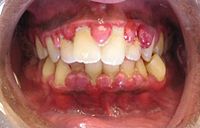
Photo from wikipedia
PURPOSE The objectives were to characterize clinico-pathologically a large series of peri-implant peripheral giant cell granuloma (PGCG), and investigate the role of foreign material as a possible etiological factor. MATERIAL… Click to show full abstract
PURPOSE The objectives were to characterize clinico-pathologically a large series of peri-implant peripheral giant cell granuloma (PGCG), and investigate the role of foreign material as a possible etiological factor. MATERIAL AND METHODS The study was retrospective, conducted on peri-implant specimens submitted for histology between 2005 and 2021. RESULTS Three hundred and thirty-five peri-implant biopsies were retrieved, of which 52 (15.5%) were PGCG. The study population included 28 females and 24 males, age 35-92 years, mean 61. 51.2% reported bone involvement. The lesion involved the margins of the specimen in 65.3%, recurrence was reported in 46.1%. In 58.8% the implant was removed at the same time the specimen was submitted for histopathological analysis. Small foci of black granular foreign material were observed in 53.8% of cases of which 67.8% were birefringent under polarized light. The foreign material granules were not ingested inside multinucleated giant cells, but were scattered in the stromal compartment. CONCLUSIONS Peri-implant PGCG is locally aggressive, with frequent bone involvement and high recurrence rate, resulting in implant loss in the majority of cases. The high recurrence rate may be related to conservative or inadequate surgery. Foreign material although common does not seem to have a role in its development.
Journal Title: Clinical implant dentistry and related research
Year Published: 2022
Link to full text (if available)
Share on Social Media: Sign Up to like & get
recommendations!